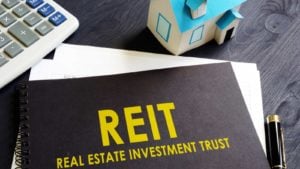Healthcare REITs have dramatically underperformed the broader market over the last 12 months due to the impact of the coronavirus crisis on their business. However, investors should not dismiss these stocks, particularly given that the broad market has doubled off its bottom last year and is now trading at a rich valuation level.
While healthcare REITs are currently hurt by the pandemic, they benefit from a strong secular trend, namely the aging of the U.S. population.
Therefore, investors with a long-term perspective should take advantage of the cheap valuation of these stocks right now. In this article, we will analyze the prospects of three healthcare REITs that have high dividend yields above 5%.
Here are three high-yield healthcare REITs to consider:
Omega Healthcare Investors (NYSE:OHI)
LTC Properties (NYSE:LTC)
LTC Properties (NASDAQ:SBRA)
High-Yield Healthcare REITs: Omega Healthcare Investors (OHI)

Omega Healthcare Investors generates over 80% of its revenues from skilled nursing facilities, and the remainder of its revenues from senior housing developments. It is the largest landlord of skilled nursing facilities in the U.S., with 954 properties.
Omega was significantly affected by the coronavirus crisis, as its occupancy declined 11% between the onset of the pandemic and January-2021. However, thanks to the massive rollout of vaccines, the business landscape has improved this year. The contagion rate within skilled nursing facilities has plunged approximately 95% since the peak of the pandemic while occupancy has improved by 3%.
Early signs of a recovery were evident in the latest earnings report of Omega. Its revenue rose 0.4% over last year’s quarter while its funds from operations per share grew 5%, from $0.81 to $0.85. It is also remarkable that the REIT collected 98% of its rental income in the second quarter and 99% of its rental income in July. Thanks to its ongoing recovery from the pandemic, Omega is on track to grow its funds from operations per share by 5% this year.
As soon as the pandemic subsides, investors will focus on the strong secular trend that supports the business of Omega, namely the aging of the U.S. population. Baby boomers began turning 75 in 2016 while the 65+ age population is expected to grow from 17% of the total U.S. population in 2020 to 21% by 2030 and 22% by 2040. This trend will greatly benefit the business of Omega, as there will be increased demand for skilled nursing facilities.
Even better for the REIT, the growth in the demand for these facilities will outpace the supply of these facilities due to certificate of need (CON) and bed moratorium restrictions. Certified facilities have remained flat for many years, with no new net supply. Overall, Omega has promising growth prospects in the long run.
Notably, Omega has raised its dividend for 17 consecutive years and currently offers a 7.8% dividend yield. Omega’s payout ratio is approximately 78% as expected for 2021, which is reasonable in the REIT universe. In addition, Omega has well-laddered debt maturities. It also has long-term leases with its operators, with an average duration of 9.0 years.
Given also that there are minimal lease expirations until 2026, Omega is likely to enjoy reliable cash flows over the next five years. As a result, its 7.8% dividend should be considered safe in the absence of a major recession.
LTC Properties (LTC)

LTC Properties invests in senior housing and skilled nursing properties. Its portfolio consists of approximately 50% senior housing and 50% skilled nursing properties. The REIT owns 180 properties in 27 states with 30 operating partners.
LTC Properties is facing a strong headwind due to the pandemic, which has put the operators of the properties of the REIT under great pressure. In the second quarter, the funds from operations per share of LTC properties decreased 25% and missed analysts’ consensus by 11%. Senior Lifestyle, an operator of some properties, did not pay for its lease obligations during the quarter and thus hurt the results of the REIT.
On the other hand, as soon as the effect of the pandemic begins to attenuate, LTC Properties will benefit from the aging of the U.S. population. This growth results from the aging of the generation of baby boomers and the consistent rise of life expectancy thanks to sustained progress in medical sciences.
LTC Properties has most of its properties in states with the highest projected increases in the 80+ population cohort over the next decade. Given also that this age category has by far the greatest spending power, the population growth in this category will greatly benefit LTC Properties in the long run.
LTC Properties has raised its dividend at a 3.7% average annual rate over the last decade and is now offering a 6.5% dividend yield.
In addition, LTC Properties has proved more vulnerable to the pandemic than Omega Healthcare Investors. Consequently, while LTC Properties has the financial power to maintain its dividend, the dividend carries a bit more risk, particularly in the event of a prolonged pandemic.
High-Yield Healthcare REITs: Sabra Health Care REIT (SBRA)

Sabra Health Care REIT owns approximately 470 properties, which are predominantly skilled nursing/traditional care facilities leased to operators under triple-net leases, which require the tenant to pay all real estate taxes, building insurance and maintenance.
Just like the other healthcare REITs, Sabra has been hurt by the pandemic. In the second quarter, its funds from operations per share dipped 5% over last year’s quarter. Due to the sustained impact of the pandemic on its business, Sabra is poised to report an approximate 10% decrease in its funds from operations per share this year.
On the bright side, the REIT has collected 99.8% of its forecasted rental income since the onset of the pandemic. While it has offered minimal rent deferrals, it has not granted any permanent concessions. Moreover, it has received material financial aid from the government, as its facilities are considered critical.
As soon as the coronavirus crisis disappears from the horizon, Sabra is likely to return to growth mode thanks to the aforementioned secular tailwind from the aging of the U.S. population. The 75-plus population cohort is expected to be the fastest-growing segment of the population, while average life expectancy is expected to rise from 79.4 years in 2015 to 81.7 years by 2030.
Due to the pandemic, Sabra cut its dividend by 33% early last year. Nevertheless, it is still offering an attractive 7.4% dividend yield. The REIT has a reasonable payout ratio of 75%, a strong interest coverage ratio of 5.2 and it has reduced its leverage ratio (net debt to EBITDA) from 5.69 in 2018 to 4.84. Therefore, its reduced dividend should be considered safe in the absence of a prolonged pandemic.
Final Thoughts
Healthcare REITs are out of favor lately due to the impact of the coronavirus on their operations. Such temporary headwinds usually present great investing opportunities. Those who believe that the pandemic will subside soon will be highly rewarded by locking in the attractive yields of the above three healthcare REITs.
Omega’s nearly 8% dividend yield makes it the most attractive of the 3 healthcare REITs here, thanks to the superior resilience of this REIT during the pandemic as well as its superior balance sheet.
On the date of publication, Bob Ciura did not have (either directly or indirectly) positions in any of the securities mentioned in this article. The opinions expressed in this article are those of the writer, subject to the InvestorPlace.com Publishing Guidelines.
Bob Ciura has worked at Sure Dividend since 2016. He oversees all content for Sure Dividend and its partner sites. Prior to joining Sure Dividend, Bob was an independent equity analyst. His articles have been published on major financial websites such as The Motley Fool, Seeking Alpha, Business Insider and more. Bob received a bachelor’s degree in Finance from DePaul University and an MBA with a concentration in investments from the University of Notre Dame.
